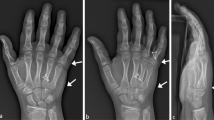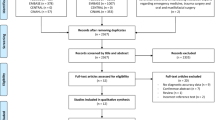Abstract
The influence of experience in categorizing suspect and occult fractures on radiography compared to MRI and clinical outcome has not been studied. The aim of this study is to evaluate the importance of experience in diagnosing normal or suspect hip radiographs compared to MRI. Primarily reported normal or suspect radiography in 254 patients with low-energy hip trauma and subsequent MRI was re-evaluated by two experienced reviewers. Primary readings and review were compared. The prevalence of fractures among normal and suspect radiographic studies was assessed. Clinical outcome was used as reference. At review of radiography, 44 fractures (17 %) were found. Significantly more fractures were found among suspect cases than among normal cases. At MRI, all 44 fractures were confirmed, and further 64 fractures were detected (25 %). MRI detected all fractures with no missed fractures revealed at follow-up. There were a significantly higher proportion of fractures at MRI among the suspect radiographic diagnoses for both the primary report and at review than among occult cases. The more experienced reviewers classified radiography examinations with higher accuracy than primary reporting general radiologists. There was almost complete agreement on MRI diagnoses.

Similar content being viewed by others
References
Kanis JA, Johnell O, De Laet C et al (2002) International variations in hip fracture probabilities: implications for risk assessment. J Bone Miner Res 17:1237–44
Sambrook P, Cooper C (2006) Osteoporosis. Lancet (London, England) 367:2010–8
National Institute of Clinical Excellence (NICE) (2011) The management of hip fracture in adults Produced by the National Clinical Guideline Centre. Royal College of Physicians (UK)
Dunker D, Collin D, Göthlin JH, Geijer M (2011) High clinical utility of computed tomography compared to radiography in elderly patients with occult hip fracture after low-energy trauma. Emerg Radiol 19:135–139
Chana R, Noorani A, Ashwood N et al (2006) The role of MRI in the diagnosis of proximal femoral fractures in the elderly. Injury 37:185–189
Sircar P, Godkar D, Mahgerefteh S et al (2007) Morbidity and mortality among patients with hip fractures surgically repaired within and after 48 hours. Am J Ther 14:508–13
Kim KC, Ha YC, Kim TY et al (2010) Initially missed occult fractures of the proximal femur in elderly patients: implications for need of operation and their morbidity. Arch Orthop Trauma Surg 130:915–920
Moran CG, Wenn RT, Sikand M, Taylor AM (2005) Early mortality after hip fracture: is delay before surgery important? J Bone Joint Surg Am 87:483–489
Panula J, Pihlajamäki H, Mattila VM et al (2011) Mortality and cause of death in hip fracture patients aged 65 or older: a population-based study. BMC Musculoskelet Disord 12:105
Pathak G, Parker MJ, Pryor GA (1997) Delayed diagnosis of femoral neck fractures. Injury 28:299–301
Parker MJ (1992) Missed hip fractures. Arch Emerg Med 9:23–27
Dominguez S, Liu P, Roberts C et al (2005) Prevalence of traumatic hip and pelvic fractures in patients with suspected hip fracture and negative initial standard radiographs--a study of emergency department patients. Acad Emerg Med 12:366–369
“Australian and New Zealand Hip Fracture Registry (ANZHFR) SteeringGroup” (2014) Australian and New Zealand guideline for hip fracture care: improving outcomes in hip fracture management of adults. Australian and New Zealand Hip Fracture Registry Steering Group, Sydney
AAOS Guidelines. Management of Hip Fractures in the Elderly. http://www.aaos.org/Research/guidelines/GuidelineHipFracture.asp. Accessed 12 Sept 2015
Landis JR, Koch GG (1977) The measurement of observer agreement for categorical data. Biometrics 33:159–174
Lim KBL, Eng AKH, Chng SM et al (2002) Limited magnetic resonance imaging (MRI) and the occult hip fracture. Ann Acad Med Singap 31:607–610
Oka M, Monu JU (2004) Prevalence and patterns of occult hip fractures and mimics revealed by MRI. AJR Am J Roentgenol 182:283–288
Frihagen F, Nordsletten L, Tariq R, Madsen JE (2005) MRI diagnosis of occult hip fractures. Acta Orthop 76:524–530
Verbeeten KM, Hermann KL, Hasselqvist M et al (2005) The advantages of MRI in the detection of occult hip fractures. Eur Radiol 15:165–169
Fairclough J, Colhoun E, Johnston D, Williams LA (1987) Bone scanning for suspected hip fractures. A prospective study in elderly patients. J Bone Joint Surg (Br) 69:251–3
Lubovsky O, Libergall M, Mattan Y, Weil Y, Mosheiff R (2005) Early diagnosis of occult hip fractures MRI versus CT scan. Injury 36(6):788–92
Gill SK, Smith J, Fox R, Chesser TJS (2013) Investigation of occult hip fractures: the use of CT and MRI. Sci World J 2013:1–4
Collin D, Dunker D, Göthlin JH, Geijer M (2011) Observer variation for radiography, computed tomography, and magnetic resonance imaging of occult hip fractures. Acta Radiol 52:871–874
Jordan R, Dickenson E, Westacott D et al (2013) A vast increase in the use of CT scans for investigating occult hip fractures. Eur J Radiol 82:e356–9
Cannon J, Silvestri S, Munro M (2009) Imaging choices in occult hip fracture. J Emerg Med 37(2):144–52
Sankey RA, Turner J, Lee J et al (2009) The use of MRI to detect occult fractures of the proximal femur: a study of 102 consecutive cases over a ten-year period. J Bone Jt Surg Br 91:1064–1068
Author information
Authors and Affiliations
Corresponding author
Ethics declarations
The study was approved by the Regional Board of Ethics
Conflict of interest
The authors declare that they have no conflict of interest.
Rights and permissions
About this article
Cite this article
Collin, D., Göthlin, J.H., Nilsson, M. et al. Added value of interpreter experience in occult and suspect hip fractures: a retrospective analysis of 254 patients. Emerg Radiol 23, 229–234 (2016). https://doi.org/10.1007/s10140-016-1385-2
Received:
Accepted:
Published:
Issue Date:
DOI: https://doi.org/10.1007/s10140-016-1385-2




